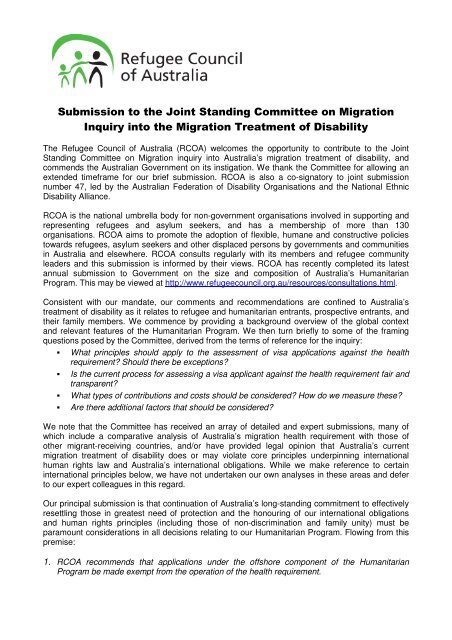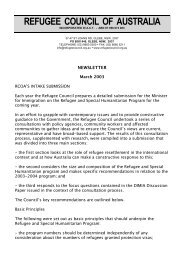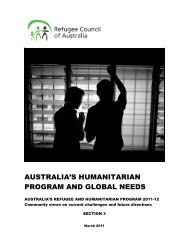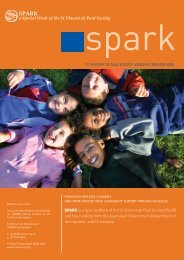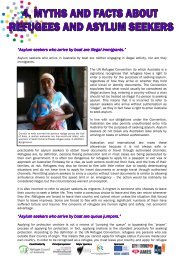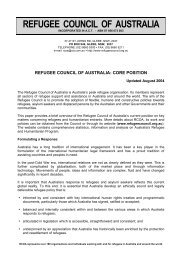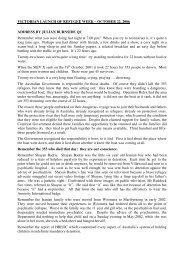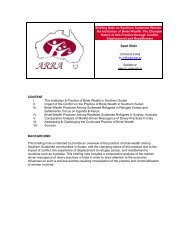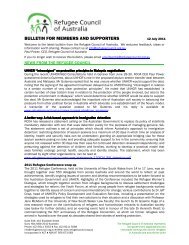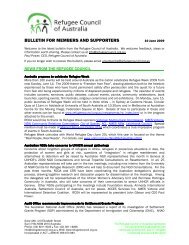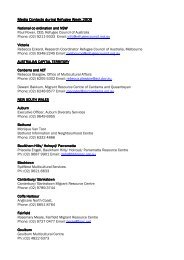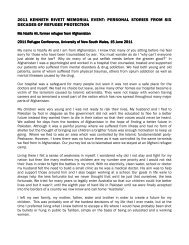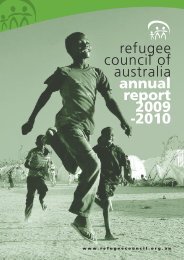Migration Treatment of Disability - Refugee Council of Australia
Migration Treatment of Disability - Refugee Council of Australia
Migration Treatment of Disability - Refugee Council of Australia
You also want an ePaper? Increase the reach of your titles
YUMPU automatically turns print PDFs into web optimized ePapers that Google loves.
Submission to the Joint Standing Committee on <strong>Migration</strong>Inquiry into the <strong>Migration</strong> <strong>Treatment</strong> <strong>of</strong> <strong>Disability</strong>The <strong>Refugee</strong> <strong>Council</strong> <strong>of</strong> <strong>Australia</strong> (RCOA) welcomes the opportunity to contribute to the JointStanding Committee on <strong>Migration</strong> inquiry into <strong>Australia</strong>’s migration treatment <strong>of</strong> disability, andcommends the <strong>Australia</strong>n Government on its instigation. We thank the Committee for allowing anextended timeframe for our brief submission. RCOA is also a co-signatory to joint submissionnumber 47, led by the <strong>Australia</strong>n Federation <strong>of</strong> <strong>Disability</strong> Organisations and the National Ethnic<strong>Disability</strong> Alliance.RCOA is the national umbrella body for non-government organisations involved in supporting andrepresenting refugees and asylum seekers, and has a membership <strong>of</strong> more than 130organisations. RCOA aims to promote the adoption <strong>of</strong> flexible, humane and constructive policiestowards refugees, asylum seekers and other displaced persons by governments and communitiesin <strong>Australia</strong> and elsewhere. RCOA consults regularly with its members and refugee communityleaders and this submission is informed by their views. RCOA has recently completed its latestannual submission to Government on the size and composition <strong>of</strong> <strong>Australia</strong>’s HumanitarianProgram. This may be viewed at http://www.refugeecouncil.org.au/resources/consultations.html.Consistent with our mandate, our comments and recommendations are confined to <strong>Australia</strong>’streatment <strong>of</strong> disability as it relates to refugee and humanitarian entrants, prospective entrants, andtheir family members. We commence by providing a background overview <strong>of</strong> the global contextand relevant features <strong>of</strong> the Humanitarian Program. We then turn briefly to some <strong>of</strong> the framingquestions posed by the Committee, derived from the terms <strong>of</strong> reference for the inquiry: What principles should apply to the assessment <strong>of</strong> visa applications against the healthrequirement? Should there be exceptions? Is the current process for assessing a visa applicant against the health requirement fair andtransparent? What types <strong>of</strong> contributions and costs should be considered? How do we measure these? Are there additional factors that should be considered?We note that the Committee has received an array <strong>of</strong> detailed and expert submissions, many <strong>of</strong>which include a comparative analysis <strong>of</strong> <strong>Australia</strong>’s migration health requirement with those <strong>of</strong>other migrant-receiving countries, and/or have provided legal opinion that <strong>Australia</strong>’s currentmigration treatment <strong>of</strong> disability does or may violate core principles underpinning internationalhuman rights law and <strong>Australia</strong>’s international obligations. While we make reference to certaininternational principles below, we have not undertaken our own analyses in these areas and deferto our expert colleagues in this regard.Our principal submission is that continuation <strong>of</strong> <strong>Australia</strong>’s long-standing commitment to effectivelyresettling those in greatest need <strong>of</strong> protection and the honouring <strong>of</strong> our international obligationsand human rights principles (including those <strong>of</strong> non-discrimination and family unity) must beparamount considerations in all decisions relating to our Humanitarian Program. Flowing from thispremise:1. RCOA recommends that applications under the <strong>of</strong>fshore component <strong>of</strong> the HumanitarianProgram be made exempt from the operation <strong>of</strong> the health requirement.
2. Should the above not be adopted, RCOA recommends, as a lesser alternative, that there be anautomatic presumption in favour <strong>of</strong> the grant <strong>of</strong> a health requirement waiver for all applicationsunder the <strong>of</strong>fshore component <strong>of</strong> the Humanitarian Program.3. RCOA recommends that all applications for family reunion made by refugees and humanitarianentrants under the general <strong>Migration</strong> Program be eligible for a health requirement waiver, withan automatic presumption in favour <strong>of</strong> a waiver grant.Overview <strong>of</strong> <strong>Australia</strong>’s Humanitarian Program within the global contextThe need for enhanced resettlement within the international protection system<strong>Australia</strong>’s Humanitarian Program sits within a challenging global context. The United Nations HighCommissioner for <strong>Refugee</strong>s (UNHCR) reports that, at the end <strong>of</strong> 2008 1 there were some 42 millionforcibly displaced people worldwide, comprising 15.2 million refugees (5.7 million <strong>of</strong> whom were inprotracted situations 2 ), 827,000 asylum-seekers and 26 million internally displaced persons, with afurther 6.6 million identified stateless persons in need <strong>of</strong> humanitarian assistance. Developingcountries are host to approximately 80 per cent <strong>of</strong> the world’s refugees.UNHCR promotes three durable solutions for refugees: voluntary repatriation in conditions <strong>of</strong>dignity and safety; local integration in a country <strong>of</strong> asylum; and resettlement in a third country,where other durable solutions are not available. UNHCR estimates that about 600,000 refugeeswill voluntarily repatriate in 2010. It estimates that resettlement is the only foreseeable durablesolution for 747,000 refugees, including 203,000 refugees who will require urgent resettlementduring 2010. 3In identifying refugees for resettlement referrals, UNHCR prioritises those with acute physical andlegal protection needs (including an imminent threat <strong>of</strong> refoulement, arbitrary arrest, or otherhuman rights violation such that asylum has become untenable) and others with heightenedvulnerabilities. The latter category may include survivors <strong>of</strong> torture and other forms <strong>of</strong> violence, andalso people with acute medical needs or disabilities if their conditions are such that they are lifethreatening without proper treatment or there is a risk <strong>of</strong> irreversible loss <strong>of</strong> functions or debilitatingaggravation <strong>of</strong> the condition in the country <strong>of</strong> asylum, and resettlement would likely improve theprognosis. Among such cases, further priority is given to those where the health condition isdirectly related to the person’s persecution, flight or exile. UNHCR policy stipulates that thosereferred for resettlement on the basis <strong>of</strong> a health condition must be resettled with their family ordependants. It further sets out that those who are well-adjusted to their disability and arefunctioning at a level deemed to be satisfactory will not be referred for resettlement on the basis <strong>of</strong>their disability. 4As noted in several other submissions to this Inquiry, disabilities and other health conditions maybe acquired or aggravated as a direct consequence <strong>of</strong> the refugee experience, which, among otherextreme hardships, may involve torture, other forms <strong>of</strong> targeted or generalised violence, protractedmalnourishment and prolonged lack <strong>of</strong> access to effective medical treatment. We note, however,the observation made by UNHCR in its submission (number 82), that a referral for resettlement onthe basis <strong>of</strong> a disability or other health condition, while feasible, is “the exception rather than therule”, with the vast majority <strong>of</strong> referrals for resettlement made on the basis <strong>of</strong> threats to protection1 UNHCR (2009), 2008 Global Trends: <strong>Refugee</strong>s, Asylum-Seekers, Returnees, Internally Displaced and Stateless Persons, June2009 at http://www.unhcr.org/4a375c426.html2 Defined as situations in which 25,000 or more refugees <strong>of</strong> the same nationality have been exiled for five or more years in a givenasylum country. ibid.3 UNHCR, UNHCR Global Appeal 2010-2011 – Finding Durable Solutions, UNHCR Fundraising Reports, December 2009 athttp://www.unhcr.org/4b03ca759.html4 UNHCR (2004), UNHCR Resettlement Handbook: Chapter 4 – UNHCR Criteria for Determining Resettlement as the AppropriateSolution, Resettlement, 1 November 2004, pp. 3,5,10-11, available at http://www.unhcr.org/3d464db54.html2
deriving from legal and physical security concerns. 5 In some instances, such as where disclosure<strong>of</strong> a person’s HIV/AIDS status results in threats to the person’s physical safety, a health conditionmay generate a referral for resettlement on the basis <strong>of</strong> protection needs. 6The destruction <strong>of</strong> the family unit is another notable characteristic <strong>of</strong> the refugee experience, withthe reconfiguration <strong>of</strong> refugee families also a common result <strong>of</strong> violence and flight (for instance,where the child <strong>of</strong> neighbours who have been killed has been absorbed, or where strongdependency relationships have developed between people who have survived and journeyedtogether). 7 Where separated family members have been traced, or new dependencies formed, theinability to reunite or to attain lasting safety together is utterly devastating to all concerned. Inaddition to the above priorities for referrals, the UNHCR Resettlement Handbook notes that “theimportance <strong>of</strong> resettlement as a tool <strong>of</strong> international protection extends to cases where it preservesor restores the basic dignity <strong>of</strong> a refugee’s life, for example, through family reunification”. 8 It furtherstates that, without effective mechanisms for the realisation <strong>of</strong> family unity, “resettlement runs therisk <strong>of</strong> not being a meaningful, durable and sustainable solution”. 9Over recent years, UNHCR has significantly increased its capacity to identify and refer refugees forresettlement. However there has been no commensurate increase in the number <strong>of</strong> places madeavailable by resettlement states. In addition, the actual number <strong>of</strong> resettlement departures fallsshort <strong>of</strong> the number <strong>of</strong> places available. In 2008, 21 states set aside 76,740 places for resettlementin cooperation with UNHCR, 10 with actual departures falling short <strong>of</strong> this figure by 11,000 places.<strong>Australia</strong>, the USA and Canada also have adjunct resettlement programs that operate without thedirect support <strong>of</strong> UNHCR. When these additional places are factored, the global refugee andhumanitarian resettlement outcome for 2008 totalled 88,800 people (<strong>of</strong> which <strong>Australia</strong> contributed11,006 places), 11 representing well under one per cent <strong>of</strong> the total refugee population.UNHCR has called for an enhanced global commitment to and capability for resettlement, in orderthat it may become a viable durable solution for an increased proportion <strong>of</strong> the world’s refugees,leading to a more equitable sharing <strong>of</strong> responsibilities within the international protection system. 12UNHCR has further encouraged states to ensure that their resettlement allocation is aligned withglobal needs and priorities, and that they remove all restrictive criteria that may undermine thefoundations <strong>of</strong> resettlement – namely, a shared commitment to the protection <strong>of</strong> those most inneed underpinned by the principle <strong>of</strong> non-discrimination. In addition to a more strategic use <strong>of</strong>resettlement, there is also a clear need for contributing countries to simplify and expedite theirresettlement procedures 13 .<strong>Australia</strong>’s contribution to international protection and corresponding benefitsState parties to the <strong>Refugee</strong> Convention (<strong>Australia</strong> is currently one <strong>of</strong> 147 parties) are obliged toprotect those who, having entered their territories or presented at their borders, are found to be5 UNHCR, October 2009, Submission to the Joint Standing Committee on <strong>Migration</strong> Inquiry into the <strong>Migration</strong> <strong>Treatment</strong> <strong>of</strong> Peoplewith a <strong>Disability</strong>, Submission No. 82, p.6 available at http://www.aph.gov.au/house/committee/mig/disability/subs/sub082.pdf6 UNHCR (2004), UNHCR Resettlement Handbook: Chapter 4, op. cit., p.117 McDonald-Wilmsen, B. & Gifford, S. (2009). <strong>Refugee</strong> resettlement, family separation and <strong>Australia</strong>’s humanitarian programme,UNHCR Policy Development and Evaluation Service, http://www.unhcr.org/4b167ae59.html, p. 2.8 UNHCR (2004), UNHCR Resettlement Handbook: Chapter 4, op. cit., p.229 ibid., p.2310 UNHCR (2009). Frequently Asked Questions About Resettlement. UNHCR Geneva. Retrieved 8/1/10,http://www.unhcr.org/4ac0873d6.html, p. 211 UNHCR (2009), 2008 Global Trends, op. cit., cited in RCOA (2010), <strong>Australia</strong>’s <strong>Refugee</strong> and Humanitarian Program 2010-11:Community views on current challenges and future directions, February 2010, p.20 available athttp://www.refugeecouncil.org.au/docs/resources/Intake%20Sub%202010-11.pdf12 UNHCR (2009), “UNHCR Projected Global Resettlement Needs 2010”. Resettling <strong>Refugee</strong>s – Sharing the Responsibility toProtect. 15 th Annual Tripartite Consultations on Resettlement. Geneva: 30 June - 2 July, pp. 5-6.13 RCOA (2009), <strong>Australia</strong>’s <strong>Refugee</strong> and Humanitarian Program: Community views on current challenges and future directions,January 2009, p.6 available at http://www.refugeecouncil.org.au/docs/resources/submissions/2009-10_intakesub.pdf3
efugees (which includes their not being subject to the Convention’s exclusion clauses). 14 Thisobligation is distinct from any contribution to the urgent global need for resettlement places. Stateparties to the <strong>Refugee</strong> Convention are also obliged to cooperate with UNHCR in the exercise <strong>of</strong> itsmandate with respect to the system <strong>of</strong> international refugee protection.<strong>Australia</strong> is a long-standing supporter <strong>of</strong> UNHCR and, along with USA and Canada, is a leaderamong resettlement states, maintaining a relatively sizeable annual resettlement program andhaving resettled around 740,000 refugees and humanitarian entrants since Federation. 15 Inaddition to its resettlement program, <strong>Australia</strong>’s contribution to the international protection systemincludes humanitarian relief and other forms <strong>of</strong> development and capacity-building assistancetargeted towards addressing the root causes <strong>of</strong> flight and improving prospects for protection andlivelihoods within countries <strong>of</strong> asylum.<strong>Australia</strong>’s Humanitarian Program has an onshore and an <strong>of</strong>fshore component, with distinctfunctions and procedures. The onshore program affords protection to refugees in accordance withour international obligations. The <strong>of</strong>fshore program reflects <strong>Australia</strong>’s long-term commitment t<strong>of</strong>urthering our contribution to the international protection regime by resettling refugees withheightened protection needs as well as others in urgent need <strong>of</strong> humanitarian assistance. TheDepartment <strong>of</strong> Immigration and Citizenship (DIAC) explains <strong>Australia</strong>’s approach as follows: “Somecountries receive large numbers <strong>of</strong> asylum seekers and focus their efforts on assisting those whoclaim protection under the <strong>Refugee</strong> Convention. As <strong>Australia</strong> receives comparatively few asylumseekers we go beyond our international obligations and work closely with UNHCR to help protectrefugees in other countries through resettlement.” 16During 2008-09 <strong>Australia</strong> issued 13,507 visas under the Humanitarian Program, just 6.6 per cent <strong>of</strong>the total 224,619 permanent additions to <strong>Australia</strong> through overall migration. The growth in theoverall migration program over the past seven years has been far greater than the modest growthin the Humanitarian Program. As a result, the Humanitarian Program as a proportion <strong>of</strong> totalmigration is now close to its lowest level in 35 years. 17 While commending Government on itssustained contribution to international protection, RCOA has long maintained that we are ablyequipped, in both experience and resources, to do more in this area, and has recently called uponGovernment to increase the Humanitarian Program to 20,000 places over the coming five years. 18While refugee and humanitarian resettlement is certainly an exercise in international goodwill,significant benefits also accrue to the receiving country. As found in RCOA’s recently releasedliterature review on the economic, social and cultural contributions <strong>of</strong> refugees, 19 with appropriateearly settlement supports, refugees and humanitarian entrants make substantial contributions totheir new countries, across all fields <strong>of</strong> endeavour. Indeed, aside from many notable contributionsto the arts, sciences, sports, media, research, business and civic and community life, five <strong>of</strong><strong>Australia</strong>’s eight billionaires listed in the 2000 Business Review Weekly’s “Rich 200” list werepeople whose families had arrived to the country as refugees. 20 Other <strong>of</strong> the positive, far-reachingeffects <strong>of</strong> refugee resettlement on the economy are more complex to measure, such as improvedeconomies <strong>of</strong> scale for service provision in regional areas, the growth <strong>of</strong> business and cultural14 See Article 1A(2) for the definition <strong>of</strong> a refugee and Articles 1F and 33(2) for the exclusion clauses. The 1951 <strong>Refugee</strong> Conventionand its 1967 Protocol are available at http://www.unhcr.org/3b66c2aa10.html . It is worthy <strong>of</strong> note that <strong>Australia</strong>’s obligation to protectextends beyond the scope <strong>of</strong> the <strong>Refugee</strong> Convention to encompass certain other human rights instruments to which we are a party.These obligations are addressed within the <strong>Migration</strong> Amendment (Complementary Protection) Bill 2009 currently before Parliament.15 RCOA (2010), <strong>Australia</strong>’s <strong>Refugee</strong> and Humanitarian Program 2010-11, op. cit., p.916 DIAC (2009), <strong>Refugee</strong> and Humanitarian Issues: <strong>Australia</strong>’s Response, June 2009 p.16 available athttp://www.immi.gov.au/media/publications/refugee/ref-hum-issues/pdf/refugee-humanitarian-issues-june09.pdf17 This figure includes temporary visa holders granted permanent residency while in <strong>Australia</strong>. See RCOA, “<strong>Australia</strong> Urged To TakeGreater Leadership In <strong>Refugee</strong> Resettlement”, 24 February 2010, athttp://www.refugeecouncil.org.au/docs/releases/2010/100224_Intake_submission.pdf18 ibid.19 RCOA (2010), Economic, Civic and Social Contributions <strong>of</strong> <strong>Refugee</strong> and Humanitarian Entrants: A Literature Review, releasedFebruary 2010, available at http://www.refugeecouncil.org.au/docs/resources/Contributions_<strong>of</strong>_refugees.pdf20 ibid., p.74
linkages between <strong>Australia</strong> and other countries, and the fact that the humanitarian intake is largelyyouthful, 21 resulting in a positive contribution to a labour market in which new retirees have beenexceeding new labour force entrants. 22Pr<strong>of</strong>essor Graeme Hugo <strong>of</strong> the University <strong>of</strong> Adelaide is currently leading substantial research intothe demographics and the economic, social and civic contribution <strong>of</strong> refugees and humanitarianentrants in <strong>Australia</strong> over time. His preliminary findings strongly bear out those <strong>of</strong> RCOA, includingthe observation that, while existing studies commonly use a very limited set <strong>of</strong> fiscal measuressuch as initial resettlement costs and short-term economic return to calculate the net impact <strong>of</strong> theHumanitarian Program, data in fact suggests that humanitarian entrants will generate a positive neteconomic contribution in the longer term. 23 Indeed, Pr<strong>of</strong>essor Hugo’s findings reveal highentrepreneurial activity among both newly arrived and former refugees and clearly indicate that,while multiple barriers including discrimination and trauma can thwart early workforce participation,within 10 to 15 years the economic performance <strong>of</strong> former refugees starts to equal or surpass that<strong>of</strong> the <strong>Australia</strong>n-born population. Where life-time and inter-generational perspectives areconsidered, the contributions across many dimensions are immense. 24The Humanitarian Program and operation <strong>of</strong> the health requirementA total <strong>of</strong> 13,750 places have been allocated to the Humanitarian Program for 2009-10. Asindicated above, the program has an onshore protection and an <strong>of</strong>fshore resettlement component.Those found to be refugees onshore are granted a Protection Visa (subclass 866). The <strong>of</strong>fshoreresettlement component <strong>of</strong> the program is made up <strong>of</strong> two main streams: The <strong>Refugee</strong> Program is for people subject to persecution in their home country, who aretypically outside <strong>of</strong> their home country, and who are in need <strong>of</strong> resettlement. It includes the<strong>Refugee</strong> (200), In-country Special Humanitarian (201), Emergency Rescue (203) and Womanat Risk (204) visa subclasses. The majority <strong>of</strong> applicants under this category are identified andreferred to <strong>Australia</strong> for resettlement by the UNHCR. A total <strong>of</strong> 6,000 places has been allocatedfor the <strong>Refugee</strong> Program during 2009-10. The Special Humanitarian Program (SHP, visa subclass 202) is for people who are outsidetheir home country, are subject to substantial persecution and/or discrimination in their homecountry amounting to a gross violation <strong>of</strong> their human rights, and are supported by an<strong>Australia</strong>n-based proposer, who will assist with the organisation and financing <strong>of</strong> travel to<strong>Australia</strong> and settlement post-arrival. The remaining 7,750 places have been allocated to theSHP for 2009-10.Incongruously, the onshore protection program is numerically linked to the SHP, such that everyonshore protection visa grant translates into a deduction from the number <strong>of</strong> places available for<strong>of</strong>fshore humanitarian resettlement. <strong>Australia</strong> is the only country to have established a numericallink between the fulfilment <strong>of</strong> its protection obligations and its resettlement quota. RCOA hasopposed this policy since its introduction in 1996, arguing that the onshore and <strong>of</strong>fshore programsare designed to meet quite different international responsibilities. The onshore protection programaims to meet <strong>Australia</strong>’s obligations as a signatory to the <strong>Refugee</strong> Convention, enabling people atrisk <strong>of</strong> persecution to seek refuge in <strong>Australia</strong>. The <strong>of</strong>fshore resettlement program is a voluntarycontribution to the sharing <strong>of</strong> international responsibility for refugees for whom no other durablesolution is available.21 RCOA (2009), Amplifying the Voices <strong>of</strong> Young <strong>Refugee</strong>s, p.4 athttp://www.refugeecouncil.org.au/docs/current/Young_<strong>Refugee</strong>s_report.pdf22 RCOA (2009), <strong>Australia</strong>’s <strong>Refugee</strong> and Humanitarian Program, op. cit., p.1523 Access Economics 2008. Migrants Fiscal Impact Model: 2008 Update: Report by Access Economics Pty Ltd for DIAC.http://www.immi.gov.au/media/publications/research/_pdf/migrants-fiscal-impact-april-2008.pdf and others cited in ibid.24 Graeme Hugo, “<strong>Refugee</strong> and Humanitarian Settlement in <strong>Australia</strong>: Recent Trends”, Presentation to Symposium on Child <strong>Refugee</strong>Health and Wellbeing, Adelaide, 29 October 2009 , available at http://www.adelaide.edu.au/hda/news/Hugo.pdf and audio filehttp://www.adelaide.edu.au/hda/news/ref%20talks/Graeme%20Hugo.mov5
There are two avenues for family reunification under the Humanitarian Program. The “split family”provisions allow those who have been granted visas (either onshore or <strong>of</strong>fshore) to propose theirimmediate family members (with some accommodation for the concept <strong>of</strong> dependency) within fiveyears <strong>of</strong> their own visa grant, provided that they declared the relationship prior to the issuing <strong>of</strong>their own visa. If the application is successful, the proposed family member will generally be issuedthe same visa subclass as the proposer but will not have to demonstrate that they are subject topersecution or discrimination. In the case <strong>of</strong> a Protection Visa (onshore applicant) proposer, thefamily member will be issued an SHP visa. “Split family” applications are also subject to a“compelling reasons” criterion. While this is a regulatory requirement, DIAC’s current policystipulates that this criterion is satisfied without further enquiry, in most cases, because theexistence <strong>of</strong> close family ties in <strong>Australia</strong> is considered to be a sufficiently compelling reason. 25 Theother avenue for family reunion under the Humanitarian Program is via the SHP. Applicants mustmeet all the standard criteria for SHP (including sponsorship for travel to <strong>Australia</strong>) anddemonstrate a particular (not necessarily immediate) familial or dependent relationship with theirsponsor, with immediate family relations accorded highest priority.Given that demand greatly exceeds places (87 per cent <strong>of</strong> SHP visa applications were rejected in2008-09), 26 many refugee and humanitarian entrants feel compelled to apply for family reunionunder the family stream <strong>of</strong> the general migration program. This attracts significantly higher supportcosts, including a two-year bar on sponsored family members accessing welfare services.Under the existing legislative, regulatory and policy framework governing the operation <strong>of</strong> thehealth requirement, different procedures and thresholds apply across many <strong>of</strong> the visa categoriesencompassed within the humanitarian and broader migration programs. Within the former, thedistinction relates specifically to whether an application is made within the onshore or <strong>of</strong>fshorecomponent <strong>of</strong> the program.Applicants for onshore protection visas are not required to meet the health requirement as, if foundto be refugees, they will be owed protection irrespective <strong>of</strong> their health status. 27 They are requiredto undergo the same health examinations as other applicants for permanent visas and toundertake to be treated or monitored for a disease or condition that could pose a threat to publichealth.Those applying under the <strong>of</strong>fshore component <strong>of</strong> the Humanitarian Program are subject to PublicInterest Criteria 4007, under Schedule 4 <strong>of</strong> the <strong>Migration</strong> Regulations 1994, which imposes thehealth requirement and also provides for its discretionary waiver where the applicant satisfies allother criteria for grant <strong>of</strong> the visa applied for, and both costs and “prejudice <strong>of</strong> access to services”are not considered “undue”. 28 The DIAC Procedures Advice Manual (PAM3) provides detailedguidance as to considerations <strong>of</strong> compelling circumstances and mitigation <strong>of</strong> health costs, andclarifies that, in considering whether the threshold <strong>of</strong> “undue” has been reached, decision makersought to weigh likely costs and prejudice <strong>of</strong> access against “the underlying purpose <strong>of</strong> the visasubclass sought and the ‘merits <strong>of</strong> the case’ (that is, the individual compassionate and compellingcircumstances <strong>of</strong> the applicant)”. 29The health requirement itself carries a “one fails all fail” rule for family applications, stipulating thatall individuals included in the visa application, and also non-migrating dependants, must meet thehealth requirement in order for visas to be approved. The waiver process allows for consideration25 The “compelling reasons” criterion is defined as follows: The Minister is satisfied that there are compelling reasons for givingspecial consideration to granting to the applicant a permanent visa, having regard to: the degree <strong>of</strong> discrimination to which theapplicant is subject in the applicant's home country; and the extent <strong>of</strong> the applicant's connection with <strong>Australia</strong>; and whether or notthere is any suitable country available, other than <strong>Australia</strong>, that can provide for the applicant settlement and protection fromdiscrimination; and the capacity <strong>of</strong> the <strong>Australia</strong>n community to provide for the permanent settlement <strong>of</strong> persons such as theapplicant in <strong>Australia</strong>. RCOA (2010), <strong>Australia</strong>’s <strong>Refugee</strong> and Humanitarian Program 2010-11, op. cit., p.1726 ibid., p.1827 see DIAC submission number 66, p.5, fn.1; and UNHCR, Submission No. 82, p.428 See Item 4007(2), Schedule 4 to the <strong>Migration</strong> Regulations 1994.29 DIAC, PAM3, available via www.LEGEND.com6
<strong>of</strong> the alternative care and welfare arrangements in place for a non-migrating dependant 30 andSchedule 2 <strong>of</strong> the <strong>Migration</strong> Regulations allows for a waiver <strong>of</strong> the health requirement for a nonmigratingdependant “if the Minister is satisfied that it would be unreasonable to require the personto undergo assessment in relation to that criterion”. 31 It is our understanding that the combination<strong>of</strong> these discretionary provisions would allow for a family that otherwise met the criteria to makethe extremely difficult decision to apply to leave behind an ordinarily dependent family memberwho might not meet the standard health requirement.Some family visa subclasses under the general <strong>Migration</strong> Program are also eligible for a healthwaiver, while others are not. As such, some <strong>of</strong> the family reunion visa subclasses that areaccessed by refugees and humanitarian entrants do not have waiver eligibility.In its submission to this Inquiry, DIAC provides statistics relating to visa refusals on health groundsand waiver grants during 2008-09. We note that, <strong>of</strong> the 1,568 visa subclass refusals, 116 fell withinthe Humanitarian Program. By contrast, we have been advised by separate correspondence that atotal <strong>of</strong> 69 applications within the Humanitarian Program were granted a health waiver during thesame period. 32 We note that 282 <strong>of</strong> the overall number <strong>of</strong> visas refused did not meet therequirement due to the “one fails all fail” rule.Key themes arising from RCOA’s consultations with its membersOur submission is informed by the views <strong>of</strong> our member organisations and refugee andhumanitarian entrants, including input received during our annual nationwide consultations, whichform the basis for RCOA’s detailed submissions to the <strong>Australia</strong>n Government regarding the size,composition and operations <strong>of</strong> the Humanitarian Program. Our consultations are broad-ranging inscope, and input regarding the operation <strong>of</strong> <strong>Australia</strong>’s migration treatment <strong>of</strong> disability has notbeen specifically sought in these fora. However, a number <strong>of</strong> prominent themes to have emergedconsistently in our consultations are relevant to this inquiry. They include the following:The critical importance <strong>of</strong> family reunion to the well-being and settlement prospects <strong>of</strong> refugeeand humanitarian entrants is perpetually raised as a priority matter, with community membersand service providers underscoring the devastating psychosocial and economic consequences<strong>of</strong> protracted family separation. Many refugees and humanitarian entrants send significantremittances overseas to support family with whom they have been unable to reunite, <strong>of</strong>ten forconsiderable periods <strong>of</strong> time and at significant personal cost. Many report a level <strong>of</strong> anguishand guilt in relation to family separation that severely hampers their capacity to fully engagewith activities associated with settlement. 33The conviction that <strong>Australia</strong>’s resettlement program should retain its focus upon those most inneed <strong>of</strong> protection is another strong theme to emerge consistently through consultations, withparticipants appreciating that this means that a balance needs to be struck with respect to thealso compelling demands for humanitarian family reunion.The need to improve transparency and accountability in the processing <strong>of</strong> <strong>of</strong>fshore visaapplications is routinely emphasised. Particular frustrations and distress <strong>of</strong>ten relate to:experiences <strong>of</strong> repeated unexplained refusals <strong>of</strong> SHP applications, incorrect details beingrecorded on applications (which in turn inhibits future split family applications), deficiencies inpre-departure health check processes, including the requirement to travel to or through areaswhich raise physical safety concerns for the purpose <strong>of</strong> undertaking tests or treatment, and30 ibid.31 See sections 200.229 (2b), 202.229 (2b), 203.229 (2b) and 204.229 (2b), Schedule 2 to the <strong>Migration</strong> Regulations 199432 It was noted that the overall number <strong>of</strong> people granted a waiver would likely exceed the number <strong>of</strong> applications given that manypeople may be included on a single application. Email dated 4 February 2010 from Health Integrity Projects, DIAC. See also DIAC,Submission 66, pp.42-333 For more detailed discussion, see, in addition to RCOA intake submissions, McDonald-Wilmsen, B. & Gifford, S. (2009), op. cit. (inparticular pp.15-24 for case studies and analysis regarding the <strong>of</strong>ten devastating psychosocial and settlement impacts <strong>of</strong> familyseparation), and RCOA (2009), “Family reunion and <strong>Australia</strong>’s <strong>Refugee</strong> and Humanitarian Program: A discussion paper”, athttp://www.refugeecouncil.org.au/docs/resources/reports/family.pdf .7
devastating decisions to split up families when one or more members are denied visas, or incircumstances where a family member’s departure is delayed (<strong>of</strong>ten by many months) due tothe results <strong>of</strong> a pre-departure medical check.Responses to questions posed by the CommitteeWhat principles should apply to the assessment <strong>of</strong> visa applications against the healthrequirement? Should there be exceptions?RCOA submits that all decisions relating to our Humanitarian Program must reinforce thecontinuation <strong>of</strong> <strong>Australia</strong>’s long-standing commitment to resettling those in greatest need <strong>of</strong>protection and ought, without exception, to ensure the honouring <strong>of</strong> our international obligationsand to fully align with established international human rights principles, specifically including those<strong>of</strong> non-discrimination, family unity, respect for human dignity, best interests <strong>of</strong> the child,inclusiveness, equality <strong>of</strong> opportunity and fairness.We join others in commending the Government on its recent ratification <strong>of</strong> the Convention on theRights <strong>of</strong> Persons with Disabilities and its Optional Protocol, and urging it to ensure that its overallmigration treatment <strong>of</strong> disability aligns in all respects with the social model <strong>of</strong> disability espousedwithin this instrument, as well as our international obligations and human rights principles morebroadly.Is the current process for assessing a visa applicant against the health requirement fair andtransparent?RCOA submits that, in light <strong>of</strong> the protection and humanitarian impetus <strong>of</strong> the program overall, it isentirely inappropriate and unfair to apply different standards and procedures in respect <strong>of</strong> thehealth requirement to the onshore and <strong>of</strong>fshore components <strong>of</strong> the Humanitarian Program, notingthat the former are designed to uphold our international obligations. RCOA sees no justifiablegrounds for the current differential treatment and urges that the standards and procedurescurrently applicable to the <strong>of</strong>fshore program be aligned with those applicable to the onshoreprogram.We note the tragic, much cited case <strong>of</strong> Mr Shahraz Kiane, a refugee who received protection in<strong>Australia</strong> and sought to sponsor his wife and children to join him. The application was rejected onthe basis that the health requirement was not met by one <strong>of</strong> his children, who had cerebral palsyand epilepsy, notwithstanding submissions regarding the existence <strong>of</strong> some extended familysupport that may have mitigated service support requirements associated with her conditions. MrKiane subsequently fatally self-immolated in front <strong>of</strong> Parliament House in Canberra. The matterwas investigated by the Commonwealth Ombudsman, who raised “serious concerns about thefairness and pr<strong>of</strong>essionalism <strong>of</strong> [the] decision-making process” 34 , called for regulatory changes tobe made to the processing <strong>of</strong> applications for family reunion under the Humanitarian Program, andmade the following observation, in his report:I consider that the grant <strong>of</strong> a refugee based visa should carry with it an expectation that therefugee’s immediate family members would normally be permitted to settle in <strong>Australia</strong>unless there were exceptional circumstances to the contrary. Introduction <strong>of</strong> cost factors tooutweigh the compassionate considerations involved would seem to be at odds with thebasic objectives <strong>of</strong> the Humanitarian Program. The current arrangements, as they stand,appear to leave open the possibility for unfair and oppressive outcomes. 3534 Commonwealth Ombudsman, ‘Ombudsman reports on events leading to refugee’s death’, athttp://www.ombudsman.gov.au/media-releases/show/1935 Commonwealth Ombudsman (2001), Report on the Investigation into a Complaint about the Processing and Refusal <strong>of</strong> a Subclass202 (Split Family) Humanitarian Visa Application, August 20018
The following two cases, raised with us by the individuals concerned during consultations, are alsoillustrative <strong>of</strong> family separation and hardship associated with a decision not to grant a waiver <strong>of</strong> thehealth requirement in relation to Humanitarian Program claims.Case study 1: Following a reunification in a refugee camp with his parents, two adultsiblings and their three children, a man and his two young sons joined the family’sapplication for resettlement to <strong>Australia</strong>. His mother, the lead applicant, advised on theapplication that her adult daughter had a mild intellectual disability but was capable <strong>of</strong>caring for herself and her own young daughter and was otherwise fit and healthy andrequired no medication for her condition. Following a medical examination, the doctorconfirmed verbally to the mother that her daughter’s condition was mild. The family’sapplication was rejected without explanation. Some time later, following significantdeterioration in camp conditions, the man decided to reapply for resettlement in <strong>Australia</strong>with his sons. They were accepted and granted refugee visas, and he made the immenselydifficult decision to accept resettlement in the hope <strong>of</strong> subsequently being able to sponsorthe remainder <strong>of</strong> their family to join them. Once in <strong>Australia</strong>, the man sought informationthrough a Freedom <strong>of</strong> Information request regarding the basis <strong>of</strong> the earlier refusal, anddiscovered that the family was rejected on the basis <strong>of</strong> projected costs associated with hissister’s disability. Neither the costs nor the nature <strong>of</strong> the anticipated treatment or serviceswere set out within the decision that he obtained. His parents and sister and her daughterhave all subsequently been accepted for resettlement elsewhere.Case study 2: A young man accepted for resettlement in <strong>Australia</strong> as a refugee haddeveloped a very close bond with another young man with whom he had shared manydifficult experiences during flight and while living in a refugee camp. Neither <strong>of</strong> the youngmen was accompanied by relatives. The medical examinations conducted in associationwith their visa applications revealed that his friend was HIV positive. His friend was rejectedfor resettlement in <strong>Australia</strong> and other people within the camp came to know <strong>of</strong> hisdiagnosis. He experienced harassment and became depressed. He was subsequentlyaccepted for resettlement elsewhere.1. RCOA recommends that applications under the <strong>of</strong>fshore component <strong>of</strong> the HumanitarianProgram be made exempt from the operation <strong>of</strong> the health requirement.While recognising that the considerations for waiver <strong>of</strong> the health requirement under PIC 4007allow for a fairly expansive and individualised consideration <strong>of</strong> compelling and compassionatecircumstances relating to a person’s application, we do not consider a discretionary procedure is afair or effective mechanism for safeguarding the protection <strong>of</strong> human rights. Notwithstanding thiscaveat, we consider that, if the above recommendation is not adopted, a presumption in favour <strong>of</strong> awaiver grant would be significantly preferable to the current circumstances. We suggest that thepolicy approach adopted by DIAC with respect to “split family” applications (as set out on page 6),might <strong>of</strong>fer a viable model, with the fact <strong>of</strong> a person meeting all other criteria for the grant <strong>of</strong> arefugee or humanitarian visa being in itself deemed a sufficiently compelling reason for a waiver <strong>of</strong>the health requirement to be applied.2. Should the above not be adopted, RCOA recommends, as a lesser alternative, that there be anautomatic presumption in favour <strong>of</strong> the grant <strong>of</strong> a health requirement waiver for all applicationsunder the <strong>of</strong>fshore component <strong>of</strong> the Humanitarian Program.Given that many refugees and humanitarian entrants are compelled to seek to reunite with theirfamily members via the general migration program, we consider that equivalent provisions to theabove ought to apply to family sponsorship processes which fall outside the HumanitarianProgram.3. RCOA recommends that all applications for family reunion made by refugees and humanitarianentrants under the general <strong>Migration</strong> Program be eligible for a health requirement waiver, withan automatic presumption in favour <strong>of</strong> a waiver grant.9
What types <strong>of</strong> contributions and costs should be considered? How do we measure these?We submit that cost considerations should not be entertained for applications under or relating tothe Humanitarian Program. We note that the number <strong>of</strong> people resettled in <strong>Australia</strong> under theHumanitarian Program is numerically small relative to the overall migration program. We furthernote that it is an immensely complex exercise to value and project individual human contributionsto a country, and that short-term quantification <strong>of</strong> projected economic outputs represents anunsophisticated and dehumanising approach. We note that, in relation to refugees, researchcurrently underway is set to reveal that, notwithstanding the considerably hardships anddisadvantages invariably faced by this population, refugees make extraordinary and diversecontributions to <strong>Australia</strong> over time.Are there additional factors that should be considered?As observed earlier, <strong>Australia</strong> is a long-standing supporter <strong>of</strong> the UNHCR and makes a highlycommendable contribution to the international protection regime. RCOA believes that reforms asrecommended above would contribute to the strengthening <strong>of</strong> resettlement as a viable durablesolution, by reinforcing its non-discriminatory underpinnings and upholding the principle <strong>of</strong> familyunity. <strong>Australia</strong> has an opportunity with this Inquiry to exercise greater leadership in an area inwhich it has and continues to make a laudable contribution.4 March 201010


